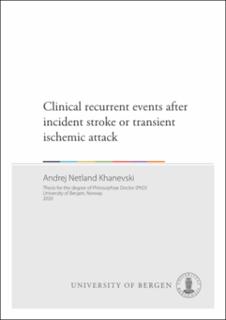| dc.contributor.author | Khanevski, Andrej Netland | en_US |
| dc.date.accessioned | 2020-03-24T13:41:41Z | |
| dc.date.available | 2020-03-24T13:41:41Z | |
| dc.date.issued | 2020-03-27 | |
| dc.date.submitted | 2020-03-05T12:01:55.646Z | |
| dc.identifier | container/73/8c/14/98/738c1498-1815-410f-9c3b-f3b74765a3fd | |
| dc.identifier.isbn | 9788230847930 | en_US |
| dc.identifier.isbn | 9788230844151 | en_US |
| dc.identifier.uri | https://hdl.handle.net/1956/21582 | |
| dc.description.abstract | Ischemic stroke survivors are at high risk of experiencing new or re-expressed focal neurological symptoms. This may be due to a recurrent stroke or due to other medical conditions, known as stroke mimics. Long-term outcomes after ischemic stroke are scarcely studied. In addition, distinguishing recurrent stroke from stroke mimics is challenging. Admissions with stroke mimics are resource-consuming and may be troublesome for the patients. Knowledge on recurrence, its associated factors, mortality and stroke mimics after ischemic stroke is of value in clinical decision-making. The present study investigated incidence, predictors and impact of recurrent stroke in a hospital-based ischemic stroke population. In addition, we investigated the burden of stroke mimics after ischemic stroke. This thesis is based on a hospital-based cohort of patients registered in the Norwegian Stroke Research Registry (NORSTROKE) at the stroke unit at the Department of Neurology, Haukeland University Hospital. A total of 1874 surviving patients who were admitted with ischemic stroke or transient ischemic attack (TIA) between July 1, 2007, and December 31, 2013 were followed for new hospital admissions with recurrent ischemic stroke/TIA or stroke mimics. The 30-day recurrence rate was 1.8%. Patients with large artery atherosclerosis and stroke of other etiology had increased risk of 30-day recurrence. The long-term recurrence rates were modest, being 5.4% and 11.3% at 1 and 5 years respectively. Hypertension, prior symptomatic stroke, chronic infarcts on MRI and increasing age were independently associated with long-term recurrence. Recurrence more than doubled the all-cause mortality. Stroke mimics were more common than recurrence after ischemic stroke or TIA. Stroke mimics were multi-etiological and unspecific diagnoses were most frequent directly after index stroke. | en_US |
| dc.language.iso | eng | eng |
| dc.publisher | The University of Bergen | eng |
| dc.relation.haspart | Paper I: Thirty-day recurrence after ischemic stroke or TIA. Khanevski AN, Bjerkreim AT, Novotny V, Naess H, Thomassen L, Logallo N, Kvistad CE. Brain and Behavior. 2018 Oct;8(10):e01108. The article is available in the main thesis. The article is also available at: <a href="https://doi.org/10.1002/brb3.1108" target="blank">https://doi.org/10.1002/brb3.1108</a> | en_US |
| dc.relation.haspart | Paper II: Recurrent ischemic stroke: incidence, predictors and impact on mortality. Khanevski AN, Bjerkreim AT, Novotny V, Naess H, Thomassen L, Logallo N, Kvistad CE; NOR-STROKE study group. Acta Neurol Scand. 2019 Jul;140(1):3-8. doi: 10.1111/ane.13093. The article is available at: <a href="http://hdl.handle.net/1956/21547" target="blank">http://hdl.handle.net/1956/21547</a> | en_US |
| dc.relation.haspart | Paper III: Incidence and etiologies of stroke mimics after incident stroke or TIA. Khanevski AN, Kvistad CE, Novotny V, Naess H, Thomassen L, Logallo N, Bjerkreim AT. Stroke. 2019;50:2937–2940. The article is not available in BORA due to publisher restrictions. The published version is available at: <a href="https://doi.org/10.1161/strokeaha.119.026573" target="blank">https://doi.org/10.1161/strokeaha.119.026573</a> | en_US |
| dc.rights | In copyright | eng |
| dc.rights.uri | http://rightsstatements.org/page/InC/1.0/ | eng |
| dc.title | Clinical recurrent events after incident stroke or transient ischemic attack | en_US |
| dc.type | Doctoral thesis | |
| dc.date.updated | 2020-03-05T12:01:55.646Z | |
| dc.rights.holder | Copyright the Author. All rights reserved | |
| dc.contributor.orcid | https://orcid.org/0000-0002-6371-628X | |
| fs.unitcode | 13-24-0 | |
